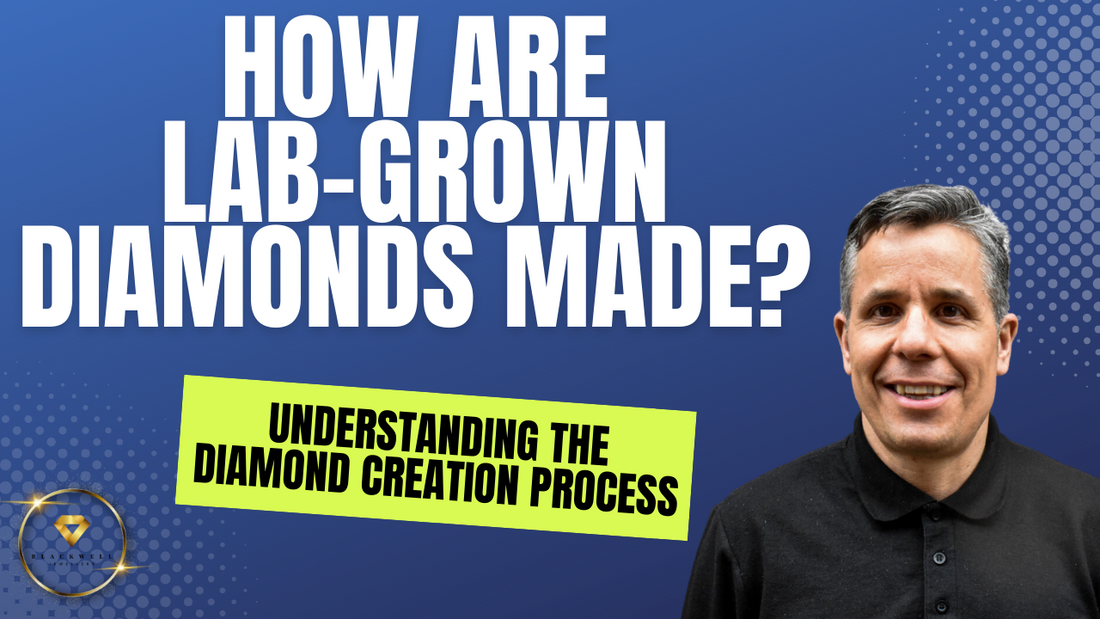Natural diamonds are absolutely amazing creations of nature, created over billions of years under extremely high heat and pressure conditions deep under the Earth's crust. It all begins with carbon sources, such as decomposing plant and animal material, which get buried and undergo temperatures exceeding 2,000°F (1,100°C) along with pressures surpassing 725,000 pounds per inch [1]. Gradually these carbon components transform into the structures that we identify as diamonds.
The essential elements required for the formation of diamonds include;
- Carbon sources (e.g. decaying organic matter)
- High temperatures (over 2,000°F/1,100°C)
- Immense pressure (over 725,000 psi)
- Billions of years of geological processes
This process showcases the forces operating within the Earth. Diamonds created through this process are referred to as "or "mined" diamonds and have been a primary source for centuries. However, in recent decades, scientists have unlocked the ability to replicate this natural process in a laboratory environment leading to the emergence of lab grown diamonds.

Replicating Nature in the Lab
The idea of creating diamonds, in a lab has been around for years tracing back to the synthesis of diamonds in the 1950s. However, it's only been in the last 10-15 years that the technology has progressed to the extent where lab created diamonds can be manufactured on a large scale with quality comparable to natural diamonds.
What is a Lab Grown Diamond Made Of?
At their core, lab-grown diamonds are composed of the exact same material as natural diamonds - 100% pure carbon. The diamond crystal structure, chemical makeup, and atomic bonding are identical whether the diamond was formed deep within the Earth's crust over billions of years or grown in a controlled laboratory environment.
The raw materials used to produce lab-grown diamonds are typically high-purity carbon sources, such as:
- Hydrocarbon gases like methane or acetylene
- Recycled diamond powder or fragments
- Other pure carbon-rich compounds
Depending on the specific diamond growth method used (HPHT or CVD), these carbon sources are subjected to the appropriate temperature, pressure, and other conditions to induce crystallisation into the distinctive diamond structure.
So while the origin story may be different, the fundamental chemical and physical properties of a lab-grown diamond are indistinguishable from a natural diamond to the naked eye. Both are pure carbon crystallised in the cubic, tetrahedral diamond lattice.
There are two primary methods used to grow diamonds in a laboratory setting:
- High Pressure High Temperature (HPHT) method
- Chemical Vapour Deposition (CVD) method

HPHT Diamond Growth
The High Pressure High Temperature (HPHT) method is the oldest commercial process for creating lab-grown diamonds. It works by replicating the immense heat and pressure conditions found deep underground that lead to natural diamond formation.
The basic HPHT process involves:
- Placing a small "seed" diamond and a carbon source material (often a hydrocarbon gas) into a specialised growth chamber.
- Subjecting this chamber to temperatures up to 2,700°F (1,500°C) and pressures over 1 million pounds per square inch.
- Under these extreme conditions, the carbon source material evaporates and recrystallizes onto the diamond seed, slowly building it up layer by layer over a period of several weeks to months.
- The resulting lab-grown diamond is then cut and polished, just like a natural diamond.
The HPHT method was first developed in the 1950s by researchers at the General Electric Company, who were able to synthesise small diamond crystals using this high-heat, high-pressure approach [3]. Over the following decades, the technology continued to evolve, allowing for the production of larger, gem-quality lab-grown diamonds.

CVD Diamond Growth
The Chemical Vapour Deposition (CVD) method is a more recently developed technique for creating lab-grown diamonds. Instead of relying on immense heat and pressure, the CVD process uses a different set of conditions to grow diamonds.
The key steps in CVD diamond growth are:
- Placing a diamond "seed" into a vacuum chamber.
- Introducing a hydrocarbon gas (such as methane) into the chamber.
- Using microwave energy to break down the gas molecules, creating a plasma that deposits carbon atoms onto the seed in a crystalline diamond structure.
- Carefully controlling the temperature, gas mixture, and other conditions to promote optimal diamond growth over a period of several weeks.
- Finally, the lab-grown CVD diamond is cut and polished for use.
The CVD method was first developed in the 1980s, building on earlier research into using plasma-enhanced chemical vapour deposition to grow diamond films [4]. Over time, the process has been refined to the point where high-quality, gem-grade CVD diamonds can be produced.
Both the HPHT and CVD methods are capable of producing high-quality diamonds that are chemically, physically, and optically identical to natural diamonds. In fact, even the most experienced gemmologists can't tell the difference with the naked eye. The only way to definitively identify a lab-grown diamond is through advanced gemmological testing equipment that can detect minute differences in trace impurities and growth patterns.

The Lab-Grown Diamond Production Process
So how do manufacturers turn these raw lab-grown diamond "stones" into the dazzling gems we see in jewellery stores? It's a multi-step process that requires precision, expertise, and high-tech equipment.
Selecting the Carbon Source
The first step is carefully selecting the carbon source material that will be used as the "feedstock" for diamond growth. This could be anything from hydrocarbon gases to recycled diamond dust [5]. The purity and composition of this carbon source has a big impact on the final quality of the lab-grown diamond.
Manufacturers often use high-purity hydrocarbon gases like methane or acetylene as the carbon source for HPHT diamond growth. For CVD, the gas mixture typically includes methane along with hydrogen and other gases. The goal is to provide a consistent, clean supply of carbon atoms that can be efficiently deposited onto the diamond seed.
Placing the "Seed" Diamond
Next, a small thin slice of a natural diamond, known as a "seed," is placed into the growth chamber. This seed provides the foundation and atomic structure that the lab-grown diamond will build upon. The seed acts as a template, guiding the carbon atoms as they crystallise into the characteristic diamond structure.
Selecting the appropriate seed diamond is crucial, as its size, orientation, and quality can all impact the final characteristics of the lab-grown stone. Manufacturers often use high-quality natural diamond fragments or recycled diamond powder as the starting seed material.
Controlling Temperature and Pressure
For HPHT growth, the temperature in the chamber is slowly ramped up to around 2,700°F (1,500°C), while the pressure is increased to over 1 million pounds per square inch. These extreme conditions cause the carbon source material to vaporise and then re-crystallize onto the diamond seed.
In the CVD process, the diamond seed is placed in a vacuum chamber. Hydrocarbon gas is introduced and broken down using microwave energy, depositing carbon atoms onto the seed in a controlled, layered growth process. The temperature is typically maintained between 1,300-1,800°F (700-980°C) during CVD diamond growth.
Throughout the growth phase, which can take anywhere from a few weeks to several months, technicians closely monitor and carefully adjust the temperature, pressure, gas mixture, and other parameters to promote optimal diamond formation. This level of precise control is key to producing high-quality, gem-grade lab-grown diamonds.
Cutting and Polishing
Once the lab-grown diamond has reached the desired size and quality, it undergoes the same cutting and polishing procedures as natural diamonds. Skilled craftspeople use specialised tools to meticulously shape and refine the diamond, maximising its brilliance, fire, and scintillation [6].
The cutting process involves carefully mapping out the optimal shape and proportions to bring out the diamond's visual appeal. Polishing then removes any surface imperfections and enhances the stone's sparkle and lustre. This is a delicate, labour-intensive operation that requires significant expertise.

Comparing Lab-Grown vs. Natural Diamonds
The end result of all this high-tech, meticulously controlled diamond growth is a gemstone that is chemically, physically, and optically identical to a natural diamond. In fact, even the most experienced gemmologists cannot distinguish a lab-grown diamond from a natural one with the naked eye.
The key similarities between lab-grown and natural diamonds include:
- Identical crystal structure (cubic, tetrahedral arrangement of carbon atoms)
- Same chemical composition (100% carbon)
- Matching optical and physical properties (refractive index, dispersion, hardness, etc.)
- Equivalent brilliance, fire, and scintillation
The only way to definitively identify a lab-grown diamond is through advanced gemmological testing equipment that can detect minute differences in trace impurities and growth patterns. But to the naked eye, and for most practical purposes, lab-grown diamonds are indistinguishable from their natural counterparts.
That said, there are some differences between lab-grown and natural diamonds that are worth noting:
- Origin: Natural diamonds form over billions of years deep within the Earth's crust, while lab-grown diamonds are produced in a matter of weeks or months using specialised equipment.
- Impurities: Natural diamonds often contain small amounts of non-carbon impurities (like nitrogen) that can affect their colour. Lab-grown diamonds tend to have fewer impurities, resulting in a higher clarity grade on average.
- Geographical Traceability: Natural diamonds can be traced back to their geographic origin, which is important for some consumers. Lab-grown diamonds do not have this same level of traceability.
- Environmental Impact: Mining natural diamonds can have a significant environmental footprint, while lab-grown diamonds are generally considered a more sustainable option.
- Pricing: Due to the automated, high-volume production process, lab-grown diamonds are typically priced at 30-50% less than comparable natural diamonds.
Despite these differences, the vast majority of consumers would be hard-pressed to notice any distinction between a lab-grown and natural diamond, especially when it comes to the final appearance and quality of the gemstone.
The Future of Lab-Grown Diamonds
As lab-grown diamond technology continues to advance, these man-made gems are becoming an increasingly popular and widely accepted alternative to natural diamonds. Several factors are driving the growth of the lab-grown diamond market:
- Cost Savings: Lab-grown diamonds can be produced at a fraction of the cost of natural diamonds, making them more affordable for consumers. This opens up diamond ownership to a wider segment of the population.
- Sustainability: Lab-grown diamonds have a much smaller environmental footprint than mined diamonds, with no impact on local ecosystems or communities. This appeals to consumers who are increasingly conscious of the ethical and environmental implications of their purchases.
- Ethical Sourcing: The lab-grown diamond supply chain is free from the concerns of "conflict diamonds" and human rights abuses often associated with traditional diamond mining. Consumers can feel good about the origin of their diamonds.
- Technological Advancements: Ongoing R&D is steadily improving the quality, size, and production efficiency of lab-grown diamonds. As the technology continues to advance, the gap between lab-grown and natural diamonds is closing.
Industry analysts predict that lab-grown diamonds will continue to grow their market share in the coming years, potentially accounting for up to 20% of global diamond sales by 2030. As these lab-grown gems become more accessible and accepted, they may fundamentally transform the traditional diamond industry.
Where are Lab Diamonds Made?
Lab-grown diamonds are primarily manufactured in specialised facilities located in a handful of countries around the world. Some of the major centres of lab-grown diamond production include:
- United States (particularly California and Arizona)
- China
- India
- Israel
- Singapore
- Russia
These countries have established sophisticated diamond growing operations that leverage advanced technologies like HPHT and CVD to produce gem-quality lab-grown diamonds on a commercial scale. Many of the world's leading lab-grown diamond producers and suppliers are headquartered in these regions.
The exact locations of individual lab-grown diamond production facilities are often kept confidential for competitive reasons. However, the infrastructure and expertise required to manufacture these high-tech gemstones is typically concentrated in areas with access to the necessary resources, talent, and technological capabilities.

Where to Buy Lab Grown Diamonds in the UK?
One of the leading retailers of lab-grown diamonds in the UK is Blackwell Jewellers. With locations across the country, Blackwell Jewellers offers a wide selection of high-quality lab-grown diamond jewellery, including engagement rings, necklaces, earrings, and more.
Blackwell Jewellers is known for its commitment to ethical and sustainable sourcing, making lab-grown diamonds a perfect fit for their product line-up. Their lab-grown diamonds are certified to be of gem-grade quality, boasting the same brilliance, fire, and sparkle as mined diamonds, but at a more accessible price point.
Customers shopping for lab-grown diamonds at Blackwell Jewellers can browse a variety of styles and settings, from classic solitaire engagement rings to modern, trendy pendant necklaces. The company's expert jewellers work closely with customers to help them find the perfect lab-grown diamond piece that fits their personal style and budget.
In addition to lab-grown diamond jewellery, Blackwell Jewellers also offers a comprehensive selection of other fine jewellery, including traditional mined diamonds, precious gemstones, and platinum or gold settings. This allows customers to compare and contrast the options, helping them make an informed decision about which type of diamond is right for them.
Whether you're in the market for an engagement ring, a special anniversary gift, or just looking to add a stunning lab-grown diamond piece to your jewellery collection, Blackwell Jewellers is an excellent destination to explore the latest in lab-grown diamond technology and craftsmanship. With competitive pricing and a commitment to customer satisfaction, we make it easy to discover the beauty and value of lab-grown diamonds.
Conclusion
The science behind lab-grown diamonds is a true marvel of human innovation. By replicating the extreme heat and pressure conditions found deep within the Earth, scientists have discovered how to create diamonds that are chemically, physically, and optically identical to natural diamonds.
Whether you're looking for an engagement ring, a pair of earrings, or just want to learn more about this fascinating technology, understanding the diamond creation process - both natural and lab-grown - can give you a deeper appreciation for these incredible gemstones.
As the lab-grown diamond market continues to evolve and grow, consumers will have more choices than ever before when it comes to selecting the perfect diamond. And with the unique benefits that lab-grown diamonds offer, it's easy to see why they are quickly becoming a preferred option for many people.
References
- Burns, R. (2009). Diamond: A unique material for the 21st century. Cambridge University Press.
- Bates, D. (2015). The history of lab-grown diamonds. Rapaport Diamond Report, 38(24), 111-112.
- Bundy, F. P. (1955). The direct conversion of graphite to diamond in static pressure apparatus. The Journal of Chemical Physics, 38(3), 631-643.
- Spear, K. E., & Dismukes, J. P. (Eds.). (1994). Synthetic diamond: Emerging CVD science and technology. Wiley.
- Shigley, J. E., Breeding, C. M., & Shen, A. H. (2004). Carbon isotope composition of gem-quality synthetic diamonds. Gems & Gemology, 40(2), 128-135.
- Gilbertson, A. (2014). The art of cutting and polishing diamonds. Gems & Gemology, 50(3), 184-201.



